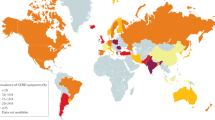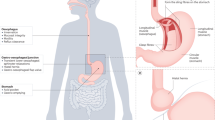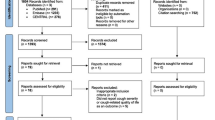Abstract
Gastroesophageal reflux disease has been increasingly associated with ear, nose and throat signs and symptoms; however, the cause and effect relationship between these two clinical entities is far from established. Many patients initially diagnosed with gastroesophageal reflux disease as the cause of laryngeal signs do not respond either symptomatically or laryngoscopically to aggressive acid suppression, and do not have abnormal esophageal acid exposure as measured by pH monitoring. This has resulted in frustration on the part of both gastroenterologists and ear, nose and throat physicians, and confusion on the part of patients. This review discusses the reasons for this controversy and highlights data that attempt to clarify this complex area.
This is a preview of subscription content, access via your institution
Access options
Subscribe to this journal
Receive 12 print issues and online access
$209.00 per year
only $17.42 per issue
Buy this article
- Purchase on Springer Link
- Instant access to full article PDF
Prices may be subject to local taxes which are calculated during checkout


Similar content being viewed by others
References
Vaezi MF et al. (2003) Laryngeal signs and symptoms and gastroesophageal reflux disease (GERD): a critical assessment of cause and effect association. Clin Gastroenterol Hepatol 1: 333–344
Koufman JA et al. (1988) Reflux laryngitis and its sequelae. J Voice 2: 78–79
Koufman JA (1991) The otolaryngologic manifestation of gastroesophageal reflux disease. Laryngoscope 101: 1–78
Toohill RJ and Kuhn JC (1997) Role of refluxed acid in pathogenesis of laryngeal disorders. Am J Med 103: 100S–106S
Gaynor EB (1991) Otolaryngologic manifestation of gastroesophageal reflux. Am J Gastroenterol 86: 801–808
Graser AG (1994) Gastroesophageal reflux and laryngeal symptoms. Aliment Pharmacol Ther 8: 265–272
Koufman JA et al. (1996) Laryngeal reflux: consensus conference. J Voice 10: 21–26
Delahunty JE and Cherry J (1968) Experimentally produced vocal cord granulomas. Laryngoscope 78: 1941–1947
Nebel OT et al. (1976) Symptomatic gastroesophageal reflux: incidence and precipitating factors. Am J Dig Dis 21: 953–956
McNally PR et al. (1989) Evaluation of gastroesophageal reflux as a cause of idiopathic hoarseness. Dig Dis Sci 34: 1900–1904
Irwin RS et al. (1977) Cough: a comprehensive review. Arch Intern Med 137: 1186–1191
Irwin RS et al. (1981) Chronic persistent cough in the adult: the spectrum and frequency of causes and successful outcome of specific therapy. Am Rev Respir Dis 123: 413–417
Irwin RS and Madison JM (2000) Anatomical diagnostic protocol in evaluating chronic cough with specific reference to gastroesophageal reflux disease. Am J Med 108 (Suppl 4a): 126S–130S
Curren JA et al. (1995) A prospective study of acid reflux and globus pharyngeus using a modified symptom index. Clin Otolarnygol Allied Sci 20: 552–554
Ott DJ et al. (1994) Globus pharyngeus: radiographic evaluation and 24-hour pH monitoring of the pharynx and esophagus in 22 patients. Radiology 191: 95–97
Feeland AP et al. (1974) Globus hystericus and reflux esophagitis. J Laryngol Otol 88: 1025–1031
Ward PH and Hanson DG (1998) Reflux as an etiological factor of carcinoma of the laryngopharynx. Laryngoscope 98: 1195–1199
Freije JE (1996) Carcinoma of the larynx in patients with gastroesophageal reflux. Am J Otolaryngol 17: 386–390
Morrison MD (1988) Is chronic gastroesophageal reflux a causative factor in glottic carcinoma? Otolaryngol Head Neck Surg 99: 370–373
Gaynor EB (1988) Gastroesophageal reflux as an etiologic factor in laryngeal complications of intubation. Laryngoscope 98: 972–979
Little FB et al. (1985) Effect of gastric acid on the pathogenesis of subglottic stenosis. Ann Otol Rhinol Laryngol 94: 516–519
Adhami T et al. (2004) Role of gastric and duodenal ingredients in laryngeal tissue injury: an experimental study in dogs. Am J Gastroenterol 99: 2098–2106
Ahmed T et al. (2005) Chronic laryngitis associated with GERD: a large scale prospective assessment of differences in practice patterns between gastroenterologists and ENT physicians [Abstract]. Gastroenterology 128: A388
Milstein C et al. Prevalence of laryngeal irritation signs associated with reflux in asymptomatic volunteers: impact of endoscopic technique (rigid vs flexible laryngoscope). Laryngoscope (in press)
Hicks DM et al. (2002) The prevalence of hypopharyngeal findings associated with gastroesophageal reflux in normal volunteers. J Voice 16: 564–579
Belafsky PC et al. (2001) The validity and reliability of the reflux finding score (RFS). Laryngoscope 111: 1313–1317
Vaezi MF et al. (2000) Are there specific laryngeal signs for gastroesophageal reflux disease? [Abstract]. Gastroenterology 118: 2639
Park W et al. (2005) Laryngopharyngeal reflux (LPR): prospective cohort study evaluating optimal dose of PPI therapy and pre-therapy predictors of response. Laryngoscope 115: 1230–1238
Branski RC et al. (2002) The reliability of the assessment of endoscopic laryngeal findings associated with laryngopharyngeal reflux disease. Laryngoscope 112: 1019–1024
Jacob P et al. (1991) Proximal esophageal pH-metry in patients with “reflux laryngitis”. Gastroenterology 100: 305–310
Katz PO (1990) Ambulatory esophageal and hypopharyngeal pH monitoring in patients with hoarseness. Am J Gastroenterol 85: 38–40
Ulualp SO et al. (1999) Pharyngeal pH monitoring in patients with posterior laryngitis. Otolaryngol Head Neck Surg 120: 672–677
Shaker R et al. (1995) Esophagopharyngeal distribution of refluxed gastric acid in patients with reflux laryngitis. Gastroenterology 109: 1575–1582
Eubanks TR et al. (2001) Pharyngeal pH monitoring in 222 patients with suspected laryngeal reflux. J Gastrointest Surg 5: 183–891
Metz DC et al. (1997) Pilot study of the oral omeprazole test for reflux laryngitis. Otolaryngol Head Neck Surg 116: 41–46
Little JP et al. (1996) Extraesophageal pediatric reflux: 24-hour double probe pH monitoring of 222 children. Ann Otol Rhinol Laryngol 169: 1–16
Chen MYM et al. (1998) Correlation of laryngeal and pharyngeal carcinomas and 24-hour pH monitoring of the esophagus and pharynx. Otolaryngol Head Neck Surg 119: 460–462
Wiener GJ et al. (1989) Chronic hoarseness secondary to gastroesophageal reflux disease: documentation with 24-hour ambulatory pH monitoring. Am J Gastroenterol 84: 1503–1508
Ossakow SJ et al. (1988) Esophageal reflux and dysmotility as the basis for persistent cervical symptoms. Ann Otol Rhinol Laryngol 96: 387–392
Wilson JA et al. (1989) Gastroesophageal reflux and posterior laryngitis. Ann Otol Rhinol Laryngol 98: 405–410
Vaezi MF et al. (1997) Reproducibility of proximal probe pH parameters in 24-hour ambulatory esophageal pH monitoring. Am J Gastroenterol 92: 825–829
Shaker R et al. (2003) Intrapharyngeal distribution of gastric acid refluxate. Laryngoscope 113: 1182–1191
Ulualp SO et al. (2001) Outcomes of acid suppressive therapy in patients with posterior laryngitis. Otolaryngol Head Neck Surg 124: 16–22
Hanson DG et al. (1995) Outcomes of antireflux therapy for the treatment of chronic laryngitis. Ann Otol Rhinol Laryngol 104: 550–555
Woo P et al. (1996) Association of esophageal reflux and globus symptom: comparison of laryngoscopy and 24-hour pH manometry. Otolaryngol Head Neck Surg 115: 502–507
Smit CF et al. (2001) Effect of cigarette smoking on gastropharyngeal and gastroesophageal reflux. Ann Otol Rhinol Laryngol 110: 190–193
Tutuian R et al. (2003) Multichannel intraluminal impedance in esophageal function testing and gastroesophageal reflux monitoring. J Clin Gastroenterol 37: 206–215
Mainie I et al. (2005) Symptom type on PPI therapy does not predict reflux identified by multichannel intraluminal impedance-pH. Gastroenterology 128 (Suppl 2): M1796
Maqbool S et al. (2005) Does combined multichannel intraluminal impedance and pH help with the diagnosis of refractory GERD? [Abstract]. Am J Gastroenterol 100: A21
Kamel PL et al. (1994) Omeprazole for the treatment of posterior laryngitis. Am J Med 96: 321–326
Shaw GY and Searl JP (1997) Laryngeal manifestations of GER before and after treatment with omeprazole. South Med J 90: 1115–1122
Wo JM et al. (1997) Empiric trial of high-dose omeprazole in patients with posterior laryngitis: a prospective study. Am J Gastro 92: 2160–2165
Ormseth EJ and Wong RKH (1999) Reflux laryngitis: pathophysiology, diagnosis and management. Am J Gastroenterol 94: 2812–2817
Peghini PL et al. (1998) Nocturnal recovery of gastric acid secretion with twice daily dosing of proton pump inhibitors. Am J Gastroenterol 93: 763–767
Peghini PL et al. (1998) Ranitidine controls nocturnal gastric acid breakthrough on omeprazole: a controlled study in normal subjects. Gastroenterology 115: 1335–1339
Fackler WK et al. (2002) Long-term effect of H2RA therapy on nocturnal gastric acid breakthrough. Gastroenterology 122: 625–632
Ours TM et al. (2003) Nocturnal acid breakthrough: clinical significance and correlation with esophageal acid exposure. Am J Gastroenterol 98: 545–550
Havas T et al. (1999) Posterior pharyngolaryngitis: double blind randomized placebo controlled trial of proton pump inhibitor therapy. Aust J Otolaryngol 3: 243–246
El-Serag H et al. (2001) Lansoprazole treatment of patients with chronic idiopathic laryngitis: a placebo controlled trial. Am J Gastroenterol 96: 979–983
Noordzij JP et al. (2001) Evaluation of omeprazole in the treatment of reflux laryngitis: a prospective placebo controlled randomized double blind study. Laryngoscope 111: 2147–2151
Eherer AJ et al. (2003) Effect of pantoprazole on the course of reflux associated laryngitis: a placebo controlled double blind cross over study. Scan J Gastroenterol 38: 462–467
Steward DL et al. (2004) Proton pump inhibitor therapy for chronic laryngo-pharyngitis: a randomized placebo controlled trial. Otolaryngol Head Neck Surg 131: 342–350
Vaezi MF et al. A randomized double blind placebo controlled study of acid suppression for the treatment of suspected laryngopharyngeal reflux. Laryngoscope (in press).
Swoger J et al. Surgical fundoplication in laryngopharyngeal reflux (LPR) unresponsive to aggressive acid suppression: a prospective concurrent controlled study. Clin Gastroenterol Hepatol (in press)
So JBY et al. (1998) Outcome of atypical symptoms attributed to gastroesophageal reflux treated by laparoscopic fundoplication. Surgery 124: 28–32
Larrain A et al. (1991) Medical and surgical treatment of nonallergic asthma associated with gastroesophageal reflux. Chest 99: 1330–1335
Klaus A et al. (2001) Laparoscopic antireflux surgery for supraesophageal complications of gastroesophageal reflux disease. Am J Med 111 (Suppl 8a): 202S–206S
Author information
Authors and Affiliations
Corresponding author
Ethics declarations
Competing interests
The author declares no competing financial interests.
Rights and permissions
About this article
Cite this article
Vaezi, M. Therapy Insight: gastroesophageal reflux disease and laryngopharyngeal reflux. Nat Rev Gastroenterol Hepatol 2, 595–603 (2005). https://doi.org/10.1038/ncpgasthep0358
Received:
Accepted:
Issue Date:
DOI: https://doi.org/10.1038/ncpgasthep0358
This article is cited by
-
Consequences of bariatric surgery on oesophageal function in health and disease
Nature Reviews Gastroenterology & Hepatology (2016)
-
Is the Proton Pump Inhibitor Test Helpful in Patients with Laryngeal Symptoms?
Digestive Diseases and Sciences (2013)
-
Extra-Esophageal Manifestations of Gerd: Who Responds to GERD Therapy?
Current Gastroenterology Reports (2013)
-
Extra-Esophageal Manifestations of Gastroesophageal Reflux Disease: Diagnosis and Treatment
Drugs (2013)
-
Extraösophageale Manifestationen der Refluxerkrankung an den Atmungsorganen
Der Gastroenterologe (2008)



